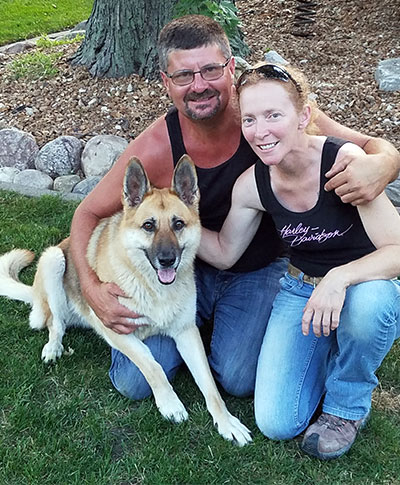‘They are more common than you think’
The heart is essential to the body, regardless of the species. Luckily, when dogs have heart problems, veterinary cardiologists, like Dr. Ryan Fries at the University of Illinois Veterinary Teaching Hospital in Urbana, are able to keep things ticking along.
Pacemakers have been used in human medicine since the early 1960s. In the late 1980s, Dr. David Sisson at the University of Illinois became one of the first veterinary cardiologists to place intravenous pacemakers in canine patients. Currently, the university’s Veterinary Teaching Hospital is the only veterinary facility in the state of Illinois that offers this procedure.
In dogs, pacemakers are used both as a life-saving intervention and to improve quality of life.
How Pacemakers Work
“A pacemaker is made up of two parts,” says Dr. Fries. “One part consists of a generator, a lithium battery, and a computer chip that we can program to meet the dog’s needs. The other part consists of wires, called leads, that extend from the generator through veins in the neck and are attached to the inside of the heart.”
The pacemaker is activated when the dog’s heart rate slows below the acceptable range set by the veterinarian, generally between 80 and 120 beats per minute. When the pacemaker kicks on, it stimulates contractions of the heart until the heart’s rhythm is reset and can continue on its own.
Cardiologists like Dr. Fries place pacemakers while the dog is under anesthesia. The surgery is most commonly done using minimally invasive techniques. The equipment used is the same that’s used in humans, but the procedure is much more affordable: “The entire procedure typically costs between $3,500 and $4,000, which is consistent with other specialized veterinary procedures,” says Dr. Fries.
How Pacemakers Are Placed
“A small incision is made in the dog’s neck, and the leads are fed through the external jugular vein, the same vein used to draw blood. Once the leads are in, the generator is tucked in the skin and stitched up,” explains Dr. Fries.
![[radiographs showing a pacemaker in place]](https://vetmed.illinois.edu/wp-content/uploads/2021/04/pc-fries-pacemaker-xrays.jpg)
“Dogs might benefit from a pacemaker if they have an arrhythmia (abnormal heart rhythm) or a heart rate that is too slow to support the dog in daily activities,” says Dr. Fries. “Some arrhythmias can stop the heart and be life-threatening. Other heart conditions may simply impede the dog’s ability to exercise and live a normal life.”
How Pacemakers Help Dogs
A classic presentation of a non-life-threatening heart problem occurs when an otherwise healthy dog suddenly faints while doing routine activities because of reduced blood flow from a slow or irregular heartbeat.
 Certain breeds are genetically predisposed to heart abnormalities that can be helped with a pacemaker. Sic-sinus syndrome, which affects heart rate, is commonly found in older West Highland white terriers, miniature schnauzers, and cocker spaniels. English springer spaniels are susceptible to a heart condition called atrial standstill.
Certain breeds are genetically predisposed to heart abnormalities that can be helped with a pacemaker. Sic-sinus syndrome, which affects heart rate, is commonly found in older West Highland white terriers, miniature schnauzers, and cocker spaniels. English springer spaniels are susceptible to a heart condition called atrial standstill.
Though not associated with a specific breed, an advanced atrioventricular (AV) block—a condition in which the impulse that causes contractions in the heart’s atrium is not conveyed appropriately to the ventricle—can be treated with a pacemaker.
“Pacemakers can be a long-term solution and often allow the dog to return to full capacity. If placed early in a dog’s life, the battery may be used enough to wear out. However, the battery can be replaced quite easily,” says Dr. Fries.
Follow-Up Care
A dog with a pacemaker will likely need checkups every six months, alternating visits between a primary care veterinarian and a veterinary cardiologist, according to Dr. Fries. If needed, the settings on the pacemaker can easily be reprogrammed by a veterinarian, who will adjust the computer program by placing a magnet over the skin. No surgery is necessary.
Following a month of rest after the surgery, dogs with pacemakers should be ready to resume normal activities. The only thing owners need to do is switch from a collar to a harness to keep pressure off the dog’s neck where the generator is.
“Pacemakers may offer the only treatment option that allows a dog to return to a normal life. We even put them in working animals that return to their jobs,” says Dr. Fries. “They are more common than you would think. There are no outward signs to tell the difference between a dog with or without one!”
If you have questions about pacemakers for dogs, contact your local veterinarian or the cardiology service at the University of Illinois Veterinary Teaching Hospital.
By Hannah Beers
Photographs courtesy of Lucy’s owner

![[patient with pacemaker is very active]](https://vetmed.illinois.edu/wp-content/uploads/2021/04/pc-pacemaker-lucy4.jpg)


